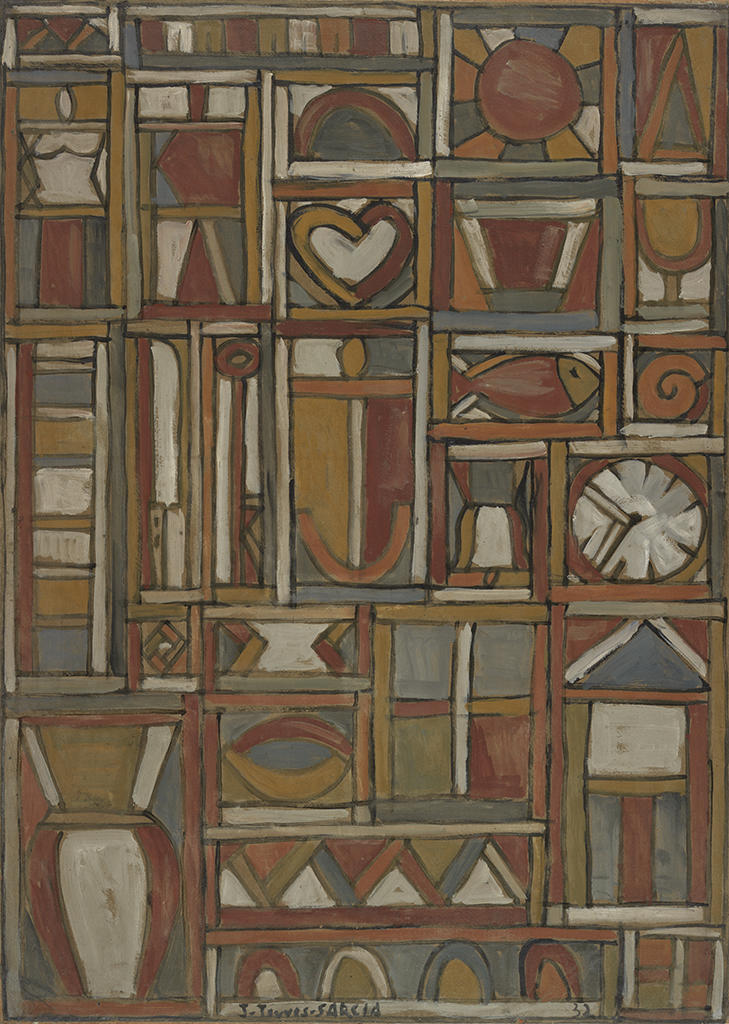Construction with Central Anchor is an image that I return to frequently with students in K-12 classrooms and in the RISD Museum. Rendered in a muted, multicolored palette, the composition is organized in an orthogonal grid, and within each window of the grid, we find a pictograph. As a symbol representing a word or phrase, the pictograph is a pervasive and powerful agent of communication. The assortment of 27 pictograms in Construction with Central Anchor begs the questions: What do these images communicate to students from diverse cultural backgrounds? In an era of emojis and visual branding at every turn, can a single image still communicate the same thing to everyone?
These questions are, in fact, directly tied to the artist’s intentions and why he chose specific images. Torres-Garcia wanted to create a “universal” language or system of images that could communicate something to everyone.
To do a close reading of Construction with Central Anchor, I invite students to break down the composition into manageable parts by drawing each pictogram they see on a separate Post-it note. Observational drawing is an effective method for previewing a work of art because it allows students to brainstorm independently prior to group discussion. I ask students to label each drawing with two words: 1) a noun to describe what the image is, and 2) a word to describe what they think the image could mean. It is emphasized that there is no right or wrong answer, and that students can write in the language that is most comfortable for them, whether English, Spanish, Portuguese, or something else.
After students gather visual information and label their drawings with words, I ask them to share their work with peers and to compare their drawings and verbal interpretations, with the goal of making categories. They begin with shared interpretations—a clock, heart, fish, or sun—and quickly advance to more ambiguous images, such as a drinking glass or human form. In collaborative exchange, students move around the table, share space, trade Post-its, and laugh. A discussion naturally unfolds as they make decisions together about categories and consider their peers’ ideas about what the images look like and mean. Some very fruitful conversations emerge from disagreeing points of view: Is that a drinking glass or a goalpost? A candle with a lit flame or a woman’s torso?
Clocks
Students use their imagination and prior experience to render, and therefore interpret, the clock with varying degrees of accuracy. We can compare their drawings with the original composition to see that students add arrows to the ends of the hour and minute hands, third hands to delineate seconds, and marks that suggest increments of time. In some cases, students draw a border around their image to emphasize Torres-Garcia’s orthogonal grid. The words clock and reloj describe the physical form, and the words time or passing time describe what the object signifies. If I were to ask you the time on the clock in Torres-Garcia’s composition, you could guesstimate by examining the picture. Yet looking closely at the students’ hour, minute, and second hands, there are a variety in times displayed. This striking difference makes me wonder: what kinds of transformations are going on? Do we just remember the image of a clock at a specific time?
Drinking glasses
Likewise, students’ drawings and labels associated with the drinking glass illustrate a wide range of styles and interpretations. The drinking glass is drawn in simple contour lines, as balanced geometric forms, and filled in with tone that represents liquid. There is a wider variety of types and specific functions in considering a cup, and some students think the image is something completely different, though still functional, like a goalpost.
Human forms
The most striking differences occur in the representations of the human form. Though a male and female appear side by side in the painting, most drawings only show the female form. Some students do not see parts of the body, but instead interpret the female torso as a candle that represents light or a window with a scalloped curtain. The drawings embrace ambiguity and assert drawing styles and individual personalities. Each demonstrates that the students have altered their drawings to support the way they perceive the image.
Pictographs of everyday life
To conclude the lesson, students are asked to create a pictogram to represent something from their everyday life. Simple, idiosyncratic drawings of a squirrel, a basketball, a car, a golden arch allude to life and activities outside of school.
The drawings, words, and respective pictorial categories that emerge in response to Torres-Garcia’s Construction with a Central Anchordemonstrate the breadth of perspectives students bring to their learning environments. Each stage of the activity encourages students to use a different entrance point to analyze images visually and verbally, and then collectively through active speaking and listening. The process of sharing and categorizing as a group encourages playful social interaction among students in a low-stakes situation. Students move from a stage of independent to group interpretation and use metacognitive skills, personal experience, and visual evidence to support their interpretations.
For dual-language learners, this activity encourages a flexible shift from image to words in many languages. English-language learners have the opportunity to demonstrate knowledge in their native language, share words with heir peers, and learn new ways of saying the same thing. Altogether, the student work has an underlying message: there is no one standard or “right” way to interpret a work of art, and every individual offers a unique perspective that we can learn from.
Noël Lefebvre is an artist-educator at the RISD Museum.
